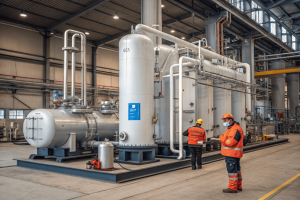How does a CO₂ recovery system benefit food and beverage manufacturers?
•
How does a CO₂ recovery system benefit food and beverage manufacturers?
Are you spending a fortune on CO₂ deliveries, only to watch your own high-purity CO₂ vent into the atmosphere? This cycle is expensive, inefficient, and bad for the environment.
A CO₂ recovery system benefits manufacturers by capturing their own fermentation CO₂. This creates a self-sufficient supply for carbonation and packaging, drastically cutting operational costs, eliminating supply chain risks, and improving the company's carbon footprint. It turns a waste stream into a valuable asset.

I have installed these systems in dozens of breweries and food processing plants, and the impact is always immediate and profound. They stop being just a consumer of CO₂ and become a producer. This fundamental shift gives them more control over their production process, their costs, and their sustainability goals. The benefits are woven into every part of their operation.
How is CO2 used in the food industry?
Your fresh products have a very short shelf life. This leads to wasted inventory, logistical headaches, and lost profits as you race against the clock to sell them.
CO₂ is a key ingredient in Modified Atmosphere Packaging (MAP). By replacing the oxygen inside a food package with CO₂, it dramatically slows down spoilage from microbes and oxidation. This extends the freshness and shelf life of countless products.

One of the most impressive applications I've seen for recovered CO₂ is in the food packaging hall. It’s a game-changer for product quality. The gas is not just filler; it is an active ingredient that protects the food from the moment it is sealed. It's a clean, safe, and highly effective way to preserve the quality your customers expect.
The Science of Freshness
The role of CO₂ in food preservation is simple but powerful. It creates an environment where the agents of decay struggle to survive. This has applications far beyond just packaging.
- Modified Atmosphere Packaging (MAP): This is the most common use. CO₂ has a bacteriostatic effect, meaning it inhibits the growth of bacteria and mold. It is often mixed with nitrogen to create the perfect protective atmosphere for products like fresh pasta, baked goods, meats, and cheeses.
- Chilling and Freezing: When liquid CO₂ expands, it becomes a very cold mixture of gas and solid particles (dry ice). This process is used for rapid chilling and freezing. Injecting CO₂ snow directly onto products like ground meat or baked goods can cool them down much faster than traditional refrigeration, locking in freshness and improving safety.
- Inerting and Blanketing: CO₂ can be used to displace oxygen from storage tanks and containers. This prevents oils, wines, and other sensitive liquids from oxidizing and losing their quality.
What is one use of carbon dioxide as it relates to the beverage industry?
Your customers expect that perfect fizz in their drink every single time. A flat beverage is a failed product, and inconsistency can damage your brand's reputation and sales.
The single most important use of carbon dioxide in the beverage industry is carbonation. Dissolving CO₂ gas into a liquid under pressure creates the bubbles, tangy taste, and appealing mouthfeel that define beer, soda, and sparkling water.

When I visit a brewery client, the conversation always turns to carbonation. It's both an art and a science. The amount of dissolved CO₂ (measured in "volumes") is a critical specification for every single product. Having a reliable, on-site source of high-purity CO₂ gives brewers the ultimate control over this crucial final step of their process, ensuring every batch meets their exact standards.
More Than Just Bubbles
While the fizz is the most obvious contribution, CO₂ plays several other vital roles in creating the perfect beverage. It's a multi-talented gas that protects and enhances the final product from tank to glass.
| Function | Role of Carbon Dioxide | Why It's Critical |
|---|---|---|
| Carbonation | Creates the dissolved bubbles, or effervescence. | Provides the classic "sparkling" sensation and tangy flavor from carbonic acid. |
| Foam & Head | Helps form and stabilize the foam head on beer. | Contributes to the aroma, appearance, and overall sensory experience. |
| Oxygen Displacement | Used to purge tanks, pipes, bottles, and cans of air before filling. | Prevents oxidation, which can cause "stale" or "cardboard-like" off-flavors. |
| Pressure Transfer | Used as a clean, inert gas to push beer from one tank to another without a pump. | A gentle, sanitary method that avoids agitating the product and introducing oxygen. |
Having your own recovered CO₂ ensures the gas used for all these critical tasks is of the highest purity, free from the contaminants that can sometimes be found in purchased CO₂.
How is carbon dioxide useful in the preservation of food and soft drinks?
Your products are at risk from invisible enemies. Microbes like bacteria and mold are constantly trying to spoil your food and drinks, leading to safety issues and financial losses.
Carbon dioxide is a powerful preservative. In food, it creates an atmosphere that inhibits microbial growth. In soft drinks, the dissolved CO₂ forms carbonic acid, which lowers the pH and creates an acidic environment where many spoilage microorganisms cannot survive.

I often explain to clients that using their own recovered CO₂ is like creating an internal insurance policy for their product quality. It’s not just about making drinks fizzy; it’s about making them stable and safe. The same gas that provides the bubbles also stands guard against the things that would otherwise ruin the product on the shelf.
The Dual Protective Mechanism
CO₂ uses a two-pronged attack to preserve quality in beverages and foods. It works on both a physical and a chemical level to extend shelf life and ensure product integrity.
- Anaerobic Environment: The most basic function is displacing oxygen. Most common spoilage microbes, like mold and aerobic bacteria, need oxygen to grow. By filling the headspace of a bottle or food package with CO₂, you physically remove a key element they need to survive. This is why a sealed bottle of soda can last for months.
- Chemical Inhibition: When CO₂ dissolves in water, it forms a small amount of carbonic acid (H₂CO₃). This is what gives carbonated water its slightly tangy taste. More importantly, this acid lowers the pH of the beverage, making it an inhospitable environment for many types of bacteria and yeast. This chemical barrier provides a second layer of protection, working alongside the lack of oxygen to keep the product fresh and safe for consumption.
Conclusion
For food and beverage makers, a CO₂ recovery system is a strategic investment. It ensures product quality, provides a reliable supply of essential gas, and cuts costs and emissions.
You may also be interested in:

Why is CO₂ recovery technology gaining popularity worldwide?
Why is CO₂ recovery technology gaining popularity worldwide? You see headlines about carbon capture everywhere. But you wonder if it's
Read more
How is a CO₂ recovery system designed to fit different industries?
How is a CO₂ recovery system designed to fit different industries? You're under pressure to implement a CO₂ recovery solution.
Read more
How energy-efficient are today’s CO₂ recovery technologies?
How energy-efficient are today’s CO₂ recovery technologies? You want to recover CO₂, but you fear that high electricity bills will
Read more